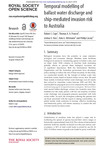Temporal modelling of ballast water discharge and ship-mediated invasion risk to Australia
| dc.contributor.author | Cope, Robert C. | en_US |
| dc.contributor.author | Prowse, Thomas A. A. | en_US |
| dc.contributor.author | Ross, Joshua V. | en_US |
| dc.date.accessioned | 2016-10-11T05:37:53Z | |
| dc.date.available | 2016-10-11T05:37:53Z | |
| dc.date.issued | 2015 | en_US |
| dc.identifier.other | HPU4160539 | en_US |
| dc.identifier.uri | https://lib.hpu.edu.vn/handle/123456789/23694 | en_US |
| dc.description.abstract | Biological invasions have the potential to cause extensive ecological and economic damage. Maritime trade facilitates biological invasions by transferring species in ballast water, and on ships’ hulls. With volumes of maritime trade increasing globally, efforts to prevent these biological invasions are of significant importance. Both the International Maritime Organization and the Australian government have developed policy seeking to reduce the risk of these invasions. In this study, we constructed models for the transfer of ballast water into Australian waters, based on historic ballast survey data. | en_US |
| dc.format.extent | 15 p. | en_US |
| dc.format.mimetype | application/pdf | en_US |
| dc.language.iso | en | en_US |
| dc.subject | Biology | en_US |
| dc.subject | Environmental science | en_US |
| dc.subject | Statistics | en_US |
| dc.subject | Ecology | en_US |
| dc.subject | Australia | en_US |
| dc.subject | Biosecurity | en_US |
| dc.subject | Invasive species | en_US |
| dc.subject | Transport | en_US |
| dc.title | Temporal modelling of ballast water discharge and ship-mediated invasion risk to Australia | en_US |
| dc.type | Article | en_US |
| dc.size | 1.06MB | en_US |
| dc.department | Education | en_US |
Files in this item
This item appears in the following Collection(s)
-
Education [806]

